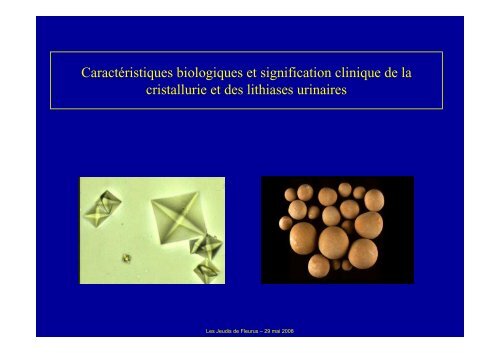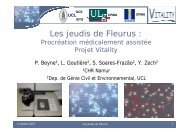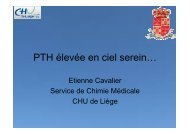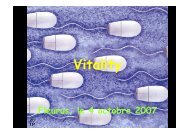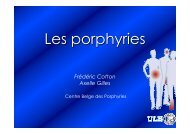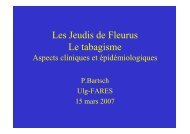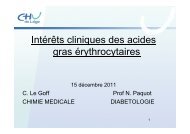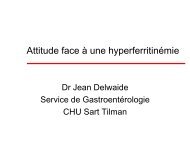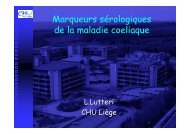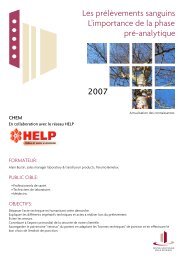Caractéristiques biologiques et signification clinique - Les Jeudis de ...
Caractéristiques biologiques et signification clinique - Les Jeudis de ...
Caractéristiques biologiques et signification clinique - Les Jeudis de ...
Create successful ePaper yourself
Turn your PDF publications into a flip-book with our unique Google optimized e-Paper software.
<strong>Caractéristiques</strong> <strong>biologiques</strong> <strong>et</strong> <strong>signification</strong> <strong>clinique</strong> <strong>de</strong> la<br />
cristallurie <strong>et</strong> <strong>de</strong>s lithiases urinaires<br />
<strong>Les</strong> <strong>Jeudis</strong> <strong>de</strong> Fleurus – 29 mai 2008
Cristallurie<br />
<strong>Les</strong> <strong>Jeudis</strong> <strong>de</strong> Fleurus – 29 mai 2008
Introduction (1/5)<br />
• Cristallurie, sursaturation urinaire<br />
• <strong>Les</strong> promoteurs <strong>et</strong> les inhibiteurs <strong>de</strong> la cristallisation<br />
• Intérêt <strong>de</strong> la cristallurie en pratique <strong>clinique</strong><br />
<strong>Les</strong> <strong>Jeudis</strong> <strong>de</strong> Fleurus – 29 mai 2008
Introduction (2/5)<br />
• La cristallurie résulte d’une sursaturation urinaire, d’une<br />
rupture d’équilibre entre promoteurs <strong>et</strong> inhibiteurs <strong>de</strong> la<br />
cristallisation urinaire.<br />
• Observée en <strong>de</strong>hors <strong>de</strong> tout contexte pathologique chez un<br />
suj<strong>et</strong> sans antécé<strong>de</strong>nts, elle traduit une sursaturation vis-àvis<br />
d’une ou <strong>de</strong> plusieurs espèce(s) cristalline(s) donnée(s).<br />
• Cependant, la simple présence <strong>de</strong> cristaux particuliers, tels<br />
ceux <strong>de</strong> cystine, dihydroxyadénine, struvite, urate<br />
d’ammonium, oriente vers <strong>de</strong>s processus pathogènes<br />
spécifiques, même en l’absence <strong>de</strong> signes <strong>clinique</strong>s.<br />
<strong>Les</strong> <strong>Jeudis</strong> <strong>de</strong> Fleurus – 29 mai 2008
Introduction (3/5)<br />
• La cristallurie peut entraîner <strong>de</strong>s lithiases, une<br />
néphrocalcinose, une insuffisance rénale aiguë ou<br />
chronique.<br />
• Contrairement au suj<strong>et</strong> normal, le lithiasique peut fabriquer<br />
<strong>de</strong>s calculs à partir <strong>de</strong>s cristaux présents dans les urines.<br />
• Dans c<strong>et</strong>te optique, l’étu<strong>de</strong> <strong>de</strong> la cristallurie s’inscrit dans<br />
une perspective <strong>de</strong> surveillance au long cours <strong>de</strong>s suj<strong>et</strong>s<br />
lithiasiques<br />
<strong>Les</strong> <strong>Jeudis</strong> <strong>de</strong> Fleurus – 29 mai 2008
LITHIASE<br />
+<br />
PROMOTEURS INHIBITEURS<br />
ANOMALIES BIOLOGIQUES<br />
RUPTURE D’EQUILIBRE<br />
SURSATURATION URINAIRE<br />
CRISTALLURIE<br />
IRA / IRC<br />
<strong>Les</strong> <strong>Jeudis</strong> <strong>de</strong> Fleurus – 29 mai 2008<br />
-<br />
NÉPHROCALCINOSE
Introduction (4/5)<br />
• <strong>Les</strong> promoteurs <strong>et</strong> les inhibiteurs <strong>de</strong> la cristallisation.<br />
• Le plus souvent, action conjointe <strong>de</strong> 2 ou 3 promoteurs.<br />
<strong>Les</strong> <strong>Jeudis</strong> <strong>de</strong> Fleurus – 29 mai 2008
PROMOTEURS<br />
Calcium<br />
Oxalate<br />
Phosphate<br />
Aci<strong>de</strong> urique<br />
Sodium<br />
Magnésium<br />
Ammonium<br />
Cystine<br />
Dihydroxyadénine<br />
Xanthine<br />
RUPTURE D’EQUILIBRE CRISTALLURIE<br />
<strong>Les</strong> <strong>Jeudis</strong> <strong>de</strong> Fleurus – 29 mai 2008<br />
INHIBITEURS<br />
Citrate<br />
Pyrophosphate<br />
Magnésium, zinc<br />
Glycoprotéines<br />
Glycosaminoglycanes<br />
Fragments d’ARN
Oxalate<br />
Calcium<br />
Phosphate<br />
Magnésium<br />
Ammonium<br />
Urate<br />
Sodium<br />
Cystine<br />
Dihydroxyadénine<br />
Xanthine<br />
PROMOTEURS ET INDUCTEURS DE CRISTALLISATION<br />
PROMOTEURS PHASES INSOLUBLES<br />
<strong>Les</strong> <strong>Jeudis</strong> <strong>de</strong> Fleurus – 29 mai 2008<br />
Oxalates <strong>de</strong> calcium<br />
Phosphates <strong>de</strong> calcium<br />
Phosphate ammon-magnésien<br />
Urate aci<strong>de</strong> d’ammonium<br />
Aci<strong>de</strong> urique<br />
Urate aci<strong>de</strong> <strong>de</strong> sodium<br />
Cystine<br />
Dihydroxyadénine<br />
Xanthine
LITHIASE<br />
+<br />
PROMOTEURS INHIBITEURS<br />
ANOMALIES BIOLOGIQUES<br />
RUPTURE D’EQUILIBRE<br />
SURSATURATION URINAIRE<br />
CRISTALLURIE<br />
IRA / IRC<br />
<strong>Les</strong> <strong>Jeudis</strong> <strong>de</strong> Fleurus – 29 mai 2008<br />
-<br />
NÉPHROCALCINOSE<br />
<strong>Les</strong> macromolécules couvrent les cristaux,<br />
entravent la croissance <strong>et</strong> l’agrégation cristalline<br />
Le citrate <strong>et</strong> le magnésium diminuent la [promoteurs]<br />
impliqués dans les espèces sursaturables
Dépistage maladies génétiques<br />
cristallogènes<br />
Intoxication<br />
éthylène glycol<br />
Facteurs <strong>de</strong> risque lithogène<br />
Introduction (5/5)<br />
Intérêt <strong>de</strong> la cristallurie en pratique <strong>clinique</strong><br />
CRISTALLURIE<br />
Détection du risque<br />
<strong>clinique</strong> <strong>de</strong> récidive<br />
<strong>Les</strong> <strong>Jeudis</strong> <strong>de</strong> Fleurus – 29 mai 2008<br />
Dépistage cristalluries<br />
médicamenteuses<br />
IRA d’origine<br />
médicamenteuse<br />
Surveillance thérapeutique
• Choix du prélèvement<br />
Première partie : aspects techniques (1/5)<br />
• Conservation du prélèvement<br />
• Préparation <strong>de</strong> l’échantillon<br />
• Métho<strong>de</strong>s d’étu<strong>de</strong><br />
• Examens à pratiquer<br />
• Mo<strong>de</strong> opératoire<br />
<strong>Les</strong> <strong>Jeudis</strong> <strong>de</strong> Fleurus – 29 mai 2008
Aspects techniques (2/5)<br />
Choix du prélèvement<br />
• 1ères urines du réveil, couvrant une longue pério<strong>de</strong> du<br />
nycthémère, <strong>et</strong> correspondant à une sursaturation souvent<br />
importante.<br />
<strong>Les</strong> <strong>Jeudis</strong> <strong>de</strong> Fleurus – 29 mai 2008
Aspects techniques (3/5)<br />
Conservation – Préparation – Métho<strong>de</strong>s d’étu<strong>de</strong><br />
• Conservées entre 20° <strong>et</strong> 37°C; jamais à 4°C<br />
Examinées au laboratoire dans les 2 heures<br />
• Préparation <strong>de</strong> l’échantillon : urine homogénéisée par<br />
r<strong>et</strong>ournement; en aucun cas il ne faut chercher à<br />
sensibiliser la recherche <strong>de</strong> cristaux (pas <strong>de</strong> culot <strong>de</strong><br />
centrifugation).<br />
• Métho<strong>de</strong> d’étu<strong>de</strong> : microscope optique avec polarisation<br />
<strong>Les</strong> <strong>Jeudis</strong> <strong>de</strong> Fleurus – 29 mai 2008
Aspects techniques (4/5)<br />
Examens à pratiquer<br />
• Protocole d’étu<strong>de</strong> standard<br />
– Echantillon traité dès réception<br />
– Mesure du pH à 0,1 ou 0,2 unités près<br />
– Mesure <strong>de</strong> la <strong>de</strong>nsité urinaire : très utile afin <strong>de</strong> juger <strong>de</strong><br />
la bonne répartition nycthémérale <strong>de</strong>s apports hydriques<br />
– > 1020 : apports hydriques mal répartis; risque <strong>de</strong> récidive<br />
pendant la nuit<br />
– < 1015 : idéale au réveil<br />
– < 1012 : idéale dans la journée<br />
– Examen au microscope à polarisation après<br />
homogénéisation par r<strong>et</strong>ournement (cellule <strong>de</strong><br />
Malassez) : hématies, leucocytes, germes, cylindres<br />
<strong>Les</strong> <strong>Jeudis</strong> <strong>de</strong> Fleurus – 29 mai 2008
Aspects techniques (5/5)<br />
Métho<strong>de</strong>s d’étu<strong>de</strong> (cas particulier)<br />
• Cas particuliers : centrifugation <strong>de</strong> l’urine dans le cadre du<br />
– diagnostic primitif d’une anomalie génétique<br />
cristallogène<br />
• Déficit en adénine phosphoribosyl transférase<br />
transmis selon le mo<strong>de</strong> autosomique récessif –<br />
cristaux <strong>de</strong> dihydroxyadénine<br />
• Cystinurie congénitale transmise selon le mo<strong>de</strong><br />
autosomique récessif – cristaux <strong>de</strong> cystine<br />
– la recherche d’une cristallurie médicamenteuse<br />
<strong>Les</strong> <strong>Jeudis</strong> <strong>de</strong> Fleurus – 29 mai 2008
• Cristaux les plus fréquents<br />
– Oxalate <strong>de</strong> calcium<br />
– Aci<strong>de</strong> urique<br />
Deuxième partie : <strong>de</strong>scription <strong>de</strong>s cristaux<br />
– Phosphates <strong>de</strong> calcium<br />
– Phosphate ammoniaco-magnésien hexahydraté (struvite)<br />
– Urate aci<strong>de</strong> d’ammonium<br />
• Cristaux peu fréquents<br />
– Origine métabolique : cystine, dihydroxyadénine, calcite<br />
– Origine médicamenteuse<br />
<strong>Les</strong> <strong>Jeudis</strong> <strong>de</strong> Fleurus – 29 mai 2008
Description <strong>de</strong>s cristaux : oxalate <strong>de</strong> calcium<br />
• Oxalate <strong>de</strong> calcium dihydraté (wed<strong>de</strong>llite)<br />
• Oxalate <strong>de</strong> calcium monohydraté (whewellite)<br />
<strong>Les</strong> <strong>Jeudis</strong> <strong>de</strong> Fleurus – 29 mai 2008
Description <strong>de</strong>s cristaux : oxalate <strong>de</strong> calcium<br />
• Oxalate <strong>de</strong> calcium dihydraté (wed<strong>de</strong>llite) :<br />
– espèce calcium dépendante<br />
urines hypercalciuriques (Ca ++ > 3,8 mmol/l)<br />
rapport molaire calcium/oxalate > 5<br />
– contexte biochimique fréquemment observé ><br />
intérêt <strong>clinique</strong> limité<br />
<strong>Les</strong> <strong>Jeudis</strong> <strong>de</strong> Fleurus – 29 mai 2008
Cristaux octaédriques<br />
Polarisation faible<br />
20 à 30 µ<br />
Description <strong>de</strong>s cristaux<br />
oxalate <strong>de</strong> calcium dihydraté (wed<strong>de</strong>llite)<br />
Cristaux dodécaédriques<br />
Hypercalciuries majeures<br />
(métaboliques)<br />
<strong>Les</strong> <strong>Jeudis</strong> <strong>de</strong> Fleurus – 29 mai 2008<br />
pH 6,1
De la <strong>de</strong>scription <strong>de</strong>s cristaux …<br />
… à la <strong>de</strong>scription <strong>de</strong>s lithiases<br />
oxalate <strong>de</strong> calcium dihydraté<br />
Surface spiculée,<br />
enchevêtrement <strong>de</strong> cristaux quadratiques<br />
aux arêtes <strong>et</strong> angles vifs ou émoussés,<br />
brun/beige/jaune<br />
Lithiase oxalique <strong>de</strong> type morphologique IIa IIb, calcium dépendante<br />
<strong>Les</strong> <strong>Jeudis</strong> <strong>de</strong> Fleurus – 29 mai 2008
Description <strong>de</strong>s cristaux : oxalate <strong>de</strong> calcium<br />
• Oxalate <strong>de</strong> calcium monohydraté (whewellite) :<br />
– espèce oxalo dépendante<br />
urines hyperoxaluriques<br />
rapport molaire calcium/oxalate < 5<br />
– rare dans les urines <strong>de</strong> suj<strong>et</strong>s normaux<br />
– essentiellement observée chez les lithiasiques<br />
présentant une hyperoxalurie<br />
• Hyperoxalurie = une <strong>de</strong>s principales causes <strong>de</strong> lithiase<br />
rénale<br />
<strong>Les</strong> <strong>Jeudis</strong> <strong>de</strong> Fleurus – 29 mai 2008
cristaux en sablier<br />
Decription <strong>de</strong>s cristaux<br />
oxalate <strong>de</strong> calcium monohydraté (whewellite)<br />
<strong>Les</strong> <strong>Jeudis</strong> <strong>de</strong> Fleurus – 29 mai 2008<br />
cristaux ovales<br />
polarisation<br />
dépression centrale
Description <strong>de</strong>s cristaux<br />
oxalate <strong>de</strong> calcium monohydraté (whewellite)<br />
<strong>Les</strong> cristaux hématiformes <strong>de</strong><br />
whewellite sont biréfringents en<br />
lumière polarisée<br />
<strong>Les</strong> <strong>Jeudis</strong> <strong>de</strong> Fleurus – 29 mai 2008
De la <strong>de</strong>scription <strong>de</strong>s cristaux …<br />
… à la <strong>de</strong>scription <strong>de</strong>s lithiases<br />
oxalate <strong>de</strong> calcium monohydraté (whewellite)<br />
Hyperoxalurie = principale cause <strong>de</strong> lithiase rénale<br />
Surface mamelonnée ou lisse,<br />
brun à brun foncé,<br />
ombilication papillaire fréquente,<br />
voile grisâtre<br />
Lithiase oxalique <strong>de</strong> type morphologique Ia, oxalo dépendante<br />
<strong>Les</strong> <strong>Jeudis</strong> <strong>de</strong> Fleurus – 29 mai 2008<br />
Section concentrique,<br />
cristallisation radiale<br />
brun foncé
Description <strong>de</strong>s cristaux : aci<strong>de</strong> urique<br />
• Aci<strong>de</strong> urique dihydraté, aci<strong>de</strong> urique anhydre, pH<br />
dépendant (pH 5,2), urines aci<strong>de</strong>s, souvent sans<br />
hyperuricurie<br />
• Urates amorphes complexes, urico dépendants<br />
<strong>Les</strong> <strong>Jeudis</strong> <strong>de</strong> Fleurus – 29 mai 2008
Description <strong>de</strong>s cristaux : aci<strong>de</strong> urique dihydraté<br />
Cristaux polychromes typiques<br />
d'aci<strong>de</strong> urique dihydraté,<br />
losangiques, aux côtés<br />
légèrement incurvés.<br />
Polarisation très intense, plus ou<br />
moins hétérogène. Dimension<br />
moyenne : 45 microns. pH : 5,3.<br />
Cristaux d'aci<strong>de</strong> urique<br />
dihydraté en bâtonn<strong>et</strong>s aux<br />
extrémités souvent amincies,<br />
dits en cacahuète.<br />
Aiguilles d'aci<strong>de</strong> urique<br />
dihydraté en aiguilles<br />
polychromes.<br />
Volumineux cristaux tabulaires<br />
d'aci<strong>de</strong> urique dihydraté, <strong>de</strong><br />
formes diverses, plus ou moins<br />
épais, agrégés. Polarisation<br />
intense, hétérogène.<br />
<strong>Les</strong> <strong>Jeudis</strong> <strong>de</strong> Fleurus – 29 mai 2008
Surface hétérogène, bosselée, rugueuse,<br />
bosselée.<br />
Couleur beige/ôcre/orangée/brun-rouille<br />
De la <strong>de</strong>scription <strong>de</strong>s cristaux …<br />
… à la <strong>de</strong>scription <strong>de</strong>s lithiases<br />
aci<strong>de</strong> urique dihydraté<br />
<strong>Les</strong> <strong>Jeudis</strong> <strong>de</strong> Fleurus – 29 mai 2008<br />
Section inorganisée, poreuse, lacunaire,<br />
avec ébauche <strong>de</strong> concentricité diffuse en<br />
périphérie.<br />
Couleur orangée.<br />
Lithiase urique <strong>de</strong> type morphologique IIIb, urico dépendante
Description <strong>de</strong>s cristaux<br />
aci<strong>de</strong> urique anhydre urates amorphes complexes<br />
Aci<strong>de</strong> urique anhydre. Sédiment ocre à orangé. -<br />
Cristaux à polarisation intense, polygonaux, à 6, 8<br />
côtés ou davantage, peu épais. Spectre<br />
infrarouge. pH : 5,5.<br />
Urates amorphes complexes. Sédiment rose carminé ou ocre clair.<br />
Granulations plus ou moins fines, légèrement polarisantes;<br />
parfois, aspect <strong>de</strong> sphères assez grosses (20-30 microns, à<br />
polarisation hétérogène donnant l'aspect <strong>de</strong> p<strong>et</strong>its grains<br />
agglomérés.<br />
Critères d'i<strong>de</strong>ntité: culot <strong>de</strong> centrifugation plus ou moins carminé,<br />
réaction <strong>de</strong> la murexi<strong>de</strong>, du sodium, du potassium positives.<br />
Spectre infrarouge. pH : 5,5 – 5,9.<br />
<strong>Les</strong> <strong>Jeudis</strong> <strong>de</strong> Fleurus – 29 mai 2008
Surface lisse, finement rugueuse,<br />
homogène.<br />
Couleur homogène, beige/jaune/orange.<br />
De la <strong>de</strong>scription <strong>de</strong>s cristaux …<br />
… à la <strong>de</strong>scription <strong>de</strong>s lithiases<br />
aci<strong>de</strong> urique anhydre<br />
<strong>Les</strong> <strong>Jeudis</strong> <strong>de</strong> Fleurus – 29 mai 2008<br />
Section concentrique à cristallisation<br />
radiale, orangée<br />
Lithiase urique <strong>de</strong> type morphologique IIIa, urico dépendante
5 formes :<br />
– carbapatite<br />
Description <strong>de</strong>s cristaux : phosphates <strong>de</strong> calcium<br />
– phosphate octocalcique pentahydraté<br />
– whitlockite<br />
– brushite (phosphate aci<strong>de</strong> <strong>de</strong> calcium dihydraté)<br />
– phosphates amorphes <strong>de</strong> calcium carbonaté<br />
<strong>Les</strong> <strong>Jeudis</strong> <strong>de</strong> Fleurus – 29 mai 2008<br />
i<strong>de</strong>ntification<br />
difficile<br />
au microscope ;<br />
recours à SIR
Phosphates amorphes <strong>de</strong> calcium<br />
carbonatés : cylindre <strong>de</strong> granulations<br />
non polarisantes amalgamées avec du<br />
mucus. pH: 7,4.<br />
Description <strong>de</strong>s cristaux<br />
phosphates amorphes <strong>de</strong> calcium carbonaté<br />
<strong>Les</strong> <strong>Jeudis</strong> <strong>de</strong> Fleurus – 29 mai 2008<br />
Phosphates amorphes <strong>de</strong> calcium<br />
carbonatés : sédiment abondant,<br />
blanchâtre, laiteux. Grosse<br />
granulations non polarisantes,<br />
isolées ou plus volontiers en amas<br />
irréguliers. pH : 5,8 - 8,5.
Description <strong>de</strong>s cristaux<br />
brushite 1/2<br />
bagu<strong>et</strong>tes <strong>de</strong> brushite<br />
agrégats <strong>de</strong> cristaux <strong>de</strong> brushite<br />
<strong>Les</strong> <strong>Jeudis</strong> <strong>de</strong> Fleurus – 29 mai 2008
Description <strong>de</strong>s cristaux<br />
<strong>Les</strong> <strong>Jeudis</strong> <strong>de</strong> Fleurus – 29 mai 2008
Nucléation<br />
hétérogène<br />
entre brushite<br />
<strong>et</strong> wed<strong>de</strong>llite<br />
Bagu<strong>et</strong>tes <strong>de</strong> brushite<br />
Description <strong>de</strong>s cristaux<br />
brushite 2/2<br />
brushite 2/2<br />
<strong>Les</strong> <strong>Jeudis</strong> <strong>de</strong> Fleurus – 29 mai 2008<br />
Mâcle <strong>de</strong><br />
brushite<br />
Agrégats <strong>de</strong><br />
mâcles <strong>de</strong><br />
brushite
Surface pommelée en chou-fleur ou<br />
finement rugueuse, <strong>de</strong> couleur beige à<br />
beige/jaune clair. Parfois fins sillons<br />
courts <strong>et</strong> sinueux.<br />
De la <strong>de</strong>scription <strong>de</strong>s cristaux …<br />
… à la <strong>de</strong>scription <strong>de</strong>s lithiases<br />
brushite<br />
<strong>Les</strong> <strong>Jeudis</strong> <strong>de</strong> Fleurus – 29 mai 2008<br />
Section concentrique <strong>et</strong> radiale beige à<br />
convergence excentrée.<br />
Lithiase <strong>de</strong> type morphologique IVd
Description <strong>de</strong>s cristaux :<br />
phosphate ammoniaco-magnésien hexahydraté (struvite)<br />
cristaux polyédriques<br />
fagot <strong>de</strong> cristaux<br />
struvite<br />
<strong>Les</strong> <strong>Jeudis</strong> <strong>de</strong> Fleurus – 29 mai 2008<br />
cristal cruciforme <strong>de</strong> struvite<br />
cristaux rectangulaires polarisants
De la <strong>de</strong>scription <strong>de</strong>s cristaux …<br />
… à la <strong>de</strong>scription <strong>de</strong>s lithiases<br />
struvite<br />
Surface pseudo-spiculée, blanche ou<br />
beige, faite <strong>de</strong> cristaux non quadratiques<br />
enchevêtrés.<br />
Lithiase <strong>de</strong> type morphologique IVc<br />
<strong>Les</strong> <strong>Jeudis</strong> <strong>de</strong> Fleurus – 29 mai 2008
Description <strong>de</strong>s cristaux :<br />
urate aci<strong>de</strong> d’ammonium<br />
granulations polarisantes cristaux sphériques<br />
urate aci<strong>de</strong><br />
d’ammonium<br />
pH 8,4<br />
cristaux en cacahuètes excroissances caractéristiques<br />
<strong>Les</strong> <strong>Jeudis</strong> <strong>de</strong> Fleurus – 29 mai 2008
• Cristaux les plus fréquents<br />
– Oxalate <strong>de</strong> calcium<br />
– Aci<strong>de</strong> urique<br />
Deuxième partie : <strong>de</strong>scription <strong>de</strong>s cristaux<br />
– Phosphates <strong>de</strong> calcium<br />
– Phosphate ammoniaco-magnésien hexahydraté (struvite)<br />
– Urate aci<strong>de</strong> d’ammonium<br />
• Cristaux peu fréquents<br />
– Origine métabolique : cystine, dihydroxyadénine, calcite<br />
– Origine médicamenteuse<br />
<strong>Les</strong> <strong>Jeudis</strong> <strong>de</strong> Fleurus – 29 mai 2008
Deuxième partie : <strong>de</strong>scription <strong>de</strong>s cristaux<br />
• Origine métabolique : cystine, dihydroxyadénine, calcite<br />
– cystine : cystinurie congénitale<br />
cristaux lamellaires hexagonaux, regroupés en agrégats, minces,<br />
non polarisants.<br />
Tendance au chevauchement <strong>et</strong> au mâclage (formation <strong>de</strong><br />
nouveaux cristaux à partir d’un cristal initial qui sert <strong>de</strong> support).<br />
– 2,8 dihydroxyadénine : déficit en adénine phosphoribosyl<br />
transférase<br />
polarisation monochrome avec croix noire centrée, <strong>et</strong> couronne<br />
noire épaisse<br />
– calcite (carbonate <strong>de</strong> calcium anhydre)<br />
<strong>Les</strong> <strong>Jeudis</strong> <strong>de</strong> Fleurus – 29 mai 2008
Description <strong>de</strong>s cristaux<br />
Cystine<br />
Dihydroxyadénine<br />
<strong>Les</strong> <strong>Jeudis</strong> <strong>de</strong> Fleurus – 29 mai 2008<br />
Calcite
Description <strong>de</strong>s cristaux<br />
<strong>Les</strong> <strong>Jeudis</strong> <strong>de</strong> Fleurus – 29 mai 2008
indinavir<br />
Aiguilles <strong>et</strong> lamelles polarisantes<br />
<strong>et</strong> agrégées parallèlement les unes<br />
aux autres. Polychromes.<br />
150 à 300 µ<br />
Bagu<strong>et</strong>tes <strong>et</strong><br />
aiguilles<br />
polarisantes.<br />
Tropisme <strong>de</strong>s GB<br />
pour les cristaux.<br />
Description <strong>de</strong>s cristaux<br />
atazanavir<br />
<strong>Les</strong> <strong>Jeudis</strong> <strong>de</strong> Fleurus – 29 mai 2008<br />
Médicaments antiviraux<br />
aciclovir<br />
Aiguilles<br />
monochromes<br />
polarisantes.<br />
350 µ
Description <strong>de</strong>s cristaux<br />
Quinolones : cristaux<br />
polarisants d'un<br />
métabolite <strong>de</strong> l'aci<strong>de</strong><br />
pipémidique (rare). <strong>Les</strong><br />
agrégats en gerbe sont<br />
irréguliers mais la<br />
convergence est<br />
généralement excentrée.<br />
Dimensions <strong>de</strong>s aiguilles<br />
: 20 - 100 microns. pH :<br />
6,6.<br />
Antibiotiques 1/2<br />
Gran<strong>de</strong>s aiguilles d'amoxicilline<br />
trihydratée isolées ou plus ou moins<br />
agrégées en rameaux <strong>de</strong> genêt, <strong>de</strong> 50<br />
à 300 microns, vues en lumière<br />
polarisée. pH : 5,8. Origine : traitement<br />
par <strong>de</strong>s doses généralement élevées<br />
d'amoxicilline (Clamoxyl).<br />
<strong>Les</strong> <strong>Jeudis</strong> <strong>de</strong> Fleurus – 29 mai 2008<br />
Cristaux en aiguilles <strong>et</strong> en<br />
bagu<strong>et</strong>tes d'ampicilline<br />
trihydratée (rare) vus en<br />
lumière polarisée. Polarisation<br />
peu intense. Dimensions :50 à<br />
400 microns. pH : 6,4.
Cristaux prismatiques polymorphes <strong>de</strong><br />
chlorydrate <strong>de</strong> N-acétylsulfaméthoxazole<br />
(Bactrim, Eusaprim). Ces cristaux,<br />
fréquemment losangiques, parfois<br />
hexagonaux, souvent épais sont facilement<br />
confondus avec les cristaux d'aci<strong>de</strong> urique<br />
dihydraté. <strong>Les</strong> formes losangiques ont<br />
généralement, pour ce <strong>de</strong>rnier, <strong>de</strong>s angles<br />
plus arrondis que dans le cas du sulfami<strong>de</strong>.<br />
Polarisation positive. Dimensions : 15 à 45<br />
microns. pH : 5,6.<br />
Description <strong>de</strong>s cristaux<br />
Antibiotiques 2/2<br />
<strong>Les</strong> <strong>Jeudis</strong> <strong>de</strong> Fleurus – 29 mai 2008<br />
P<strong>et</strong>its cristaux <strong>de</strong> Nacétylsulfadiazine<br />
(rare) en<br />
aiguilles polarisantes<br />
agrégées en aigr<strong>et</strong>tes<br />
rayonnantes. Dimensions :<br />
10-20 microns. pH : 7,3.<br />
Origine : traitement par<br />
sulfadiazine (Adiazine).
Troisième partie : cristallurie en pratique<br />
• Importance <strong>de</strong> la mesure du pH<br />
RELATION ENTRE PHASES CRISTALLINES ET pH<br />
UrAm<br />
AU2<br />
5,0<br />
UAC<br />
5,20<br />
5,55<br />
Struvite<br />
PACC/CA<br />
Brushite<br />
WHE<br />
WED<br />
5,90<br />
6,35<br />
6,65<br />
7,45<br />
6,0 7,0 8,0<br />
<strong>Les</strong> <strong>Jeudis</strong> <strong>de</strong> Fleurus – 29 mai 2008<br />
7,95
Troisième partie : cristallurie en pratique<br />
domaine <strong>de</strong> pH <strong>de</strong> quelques espèces cristallines<br />
Whewellite (OxCa monohydraté)<br />
Wed<strong>de</strong>llite (OxCa dihydraté)<br />
Oxalate <strong>de</strong> calcium trihydraté<br />
Aci<strong>de</strong> urique anhydre<br />
Aci<strong>de</strong> urique monohydraté<br />
Aci<strong>de</strong> urique dihydraté<br />
Urates amorphes complexes<br />
Urate aci<strong>de</strong> d'ammonium anhydre<br />
Urate aci<strong>de</strong> <strong>de</strong> sodium monohydraté<br />
Urate aci<strong>de</strong> <strong>de</strong> calcium hexahydraté<br />
Urate aci<strong>de</strong> <strong>de</strong> magnésium hexahydraté<br />
Urate double <strong>de</strong> potassium <strong>et</strong> <strong>de</strong> sodium<br />
Dihydroxy-2,8 adénine<br />
Xanthine<br />
Phosphates amorphes <strong>de</strong> calcium carbonatés<br />
Carbapatite (PhCa carbonaté cristallisé)<br />
Brushite (PhCa aci<strong>de</strong> dihydraté)<br />
Phosphate octocalcique pentahydraté<br />
Whitlockite (PhCa <strong>et</strong> Mg hydraté)<br />
Struvite phosphate ammoniacomagnésien hexa<br />
<strong>Les</strong> <strong>Jeudis</strong> <strong>de</strong> Fleurus – 29 mai 2008<br />
5,2-7,8<br />
5,2-7,6<br />
5,0-7,6<br />
5,0-5,8<br />
5,0-5,8<br />
4,6-5,9<br />
5,2-6,2<br />
6,4-9,0<br />
6,4-9,0<br />
6,6-9,0<br />
6,6-9,0<br />
6,6-9,0<br />
4,7-9,0<br />
4,7-7,0<br />
5,9-9,0<br />
5,9-9,0<br />
5,5-8,8<br />
5,9-9,0<br />
5,9-9,0<br />
6,7-9,0
Troisième partie : cristallurie en pratique<br />
• Importance <strong>de</strong> la mesure du pH dans le cas particulier <strong>de</strong><br />
l’urate d’ammonium :<br />
hyperuricurie + hyperammoniurie<br />
– pH = 6,5 : diarrhées électrolytiques chez le dénutri,<br />
l’anorexique :<br />
perte <strong>de</strong> bicarbonates, sodium <strong>et</strong> potassium dans les selles.<br />
Acidose métabolique. Augmentation <strong>de</strong> la synthèse rénale<br />
d’ammonium pour compenser la charge aci<strong>de</strong> (le tampon<br />
phosphate fonctionne moins bien, car carence en<br />
phosphore). Urines concentrées (par perte <strong>de</strong> liqui<strong>de</strong>s).<br />
Uricurie élevée.<br />
– pH = 7,5 – 8,0 : infections urinaires à germes uréasiques<br />
<strong>Les</strong> <strong>Jeudis</strong> <strong>de</strong> Fleurus – 29 mai 2008
Altération <strong>de</strong> l'épithélium NH 3<br />
Adhésion <strong>de</strong>s bactéries<br />
Mg 2+ +<br />
PO 4 3-<br />
Uréase<br />
Urée<br />
H 2 N-CO-NH 2<br />
<strong>Les</strong> <strong>Jeudis</strong> <strong>de</strong> Fleurus – 29 mai 2008<br />
CO 2<br />
pH > 8 NH 4 + HCO 3 - CO 3 2-<br />
phosphate ammoniacomagnésien<br />
hexahydraté<br />
phosphate <strong>de</strong> calcium<br />
carbonaté<br />
+ hyperuricurie urate d’ammonium<br />
Ca 2+ +<br />
PO 4 3-
Troisième partie : cristallurie en pratique<br />
• Principaux facteurs <strong>de</strong> risque d’une cristallurie mesurables<br />
– Oxalate > 0,3 mmol/l<br />
– Phosphate > 24 mmol/l<br />
– Calcium > 3,8 mmol/l<br />
– Urate > 3,5 mmol/l si pH >= 6,0<br />
> 2,0 mmol/l si pH 1012 journée<br />
<strong>Les</strong> <strong>Jeudis</strong> <strong>de</strong> Fleurus – 29 mai 2008
• Rôle déterminant <strong>de</strong> la <strong>de</strong>nsité<br />
<strong>de</strong> l’urine dans la cristallogenèse.<br />
Au seuil <strong>de</strong> 1012, doublement<br />
<strong>de</strong> la présence <strong>de</strong> cristaux.<br />
Troisième partie : cristallurie en pratique<br />
<strong>Les</strong> <strong>Jeudis</strong> <strong>de</strong> Fleurus – 29 mai 2008
• 7 critères<br />
Quatrième partie :<br />
critères d’interprétation d’une cristallurie<br />
– Nature chimique <strong>de</strong>s cristaux<br />
– Nature cristalline<br />
– Faciès cristallin<br />
– Taille <strong>de</strong>s cristaux<br />
– Taux d’agrégation <strong>de</strong>s cristaux<br />
– Fréquence <strong>de</strong> la cristallurie<br />
– Abondance <strong>de</strong> la cristallurie<br />
<strong>Les</strong> <strong>Jeudis</strong> <strong>de</strong> Fleurus – 29 mai 2008
Quatrième partie :<br />
critères d’interprétation d’une cristallurie<br />
– Nature chimique <strong>de</strong>s cristaux<br />
• cystine : cystinurie congénitale<br />
• dihydroxyadénine : déficit homozygote en adénine<br />
phosphoribosyltransférase<br />
• xanthine : déficit homozygote en xanthine<br />
déshydrogénase<br />
• struvite (phosphate ammoniaco magnésien hexa<br />
hydraté): infections urinaires à germes uréasiques<br />
• urate d’ammonium : hyperuricurie +<br />
hyperammoniurie<br />
– pH = 6,5 : diarrhées électrolytiques chez le dénutri<br />
– pH = 7,5 – 8,0 : infections urinaires à germes uréasiques<br />
• médicaments : antibiotiques, antiviraux<br />
<strong>Les</strong> <strong>Jeudis</strong> <strong>de</strong> Fleurus – 29 mai 2008
• 7 critères<br />
Quatrième partie :<br />
critères d’interprétation d’une cristallurie<br />
– Nature chimique <strong>de</strong>s cristaux<br />
– Nature cristalline<br />
– Faciès cristallin<br />
– Taille <strong>de</strong>s cristaux<br />
– Taux d’agrégation <strong>de</strong>s cristaux<br />
– Fréquence <strong>de</strong> la cristallurie<br />
– Abondance <strong>de</strong> la cristallurie<br />
<strong>Les</strong> <strong>Jeudis</strong> <strong>de</strong> Fleurus – 29 mai 2008
Quatrième partie :<br />
critères d’interprétation d’une cristallurie<br />
– Nature cristalline<br />
• oxalate <strong>de</strong> calcium :<br />
– oxalate <strong>de</strong> calcium monohydraté (whewellite)<br />
» hyperoxalurie<br />
– oxalate <strong>de</strong> calcium dihydraté (wed<strong>de</strong>llite)<br />
» hypercalciurie +/- hyperoxalurie<br />
• phosphate <strong>de</strong> calcium :<br />
– phosphate aci<strong>de</strong> <strong>de</strong> calcium dihydraté (brushite)<br />
» hypercalciurie, hypocitraturie, pH 6,0-6,5<br />
– carbapatite (phosphate <strong>de</strong> calcium carbonaté); phosphate<br />
amorphe <strong>de</strong> calcium carbonaté ; whitlockite (phosphate mixte <strong>de</strong><br />
calcium <strong>et</strong> <strong>de</strong> magnésium hydraté)<br />
» hypercalciurie, infections urinaires<br />
• aci<strong>de</strong> urique :<br />
– aci<strong>de</strong> urique anhydre, aci<strong>de</strong> urique dihydraté<br />
» marqueur d’acidité<br />
– urates amorphes complexes<br />
» hyperuricurie<br />
<strong>Les</strong> <strong>Jeudis</strong> <strong>de</strong> Fleurus – 29 mai 2008
• 7 critères<br />
Quatrième partie :<br />
critères d’interprétation d’une cristallurie<br />
– Nature chimique <strong>de</strong>s cristaux<br />
– Nature cristalline<br />
– Faciès cristallin<br />
– Abondance <strong>de</strong> la cristallurie<br />
– Taille <strong>de</strong>s cristaux<br />
– Taux d’agrégation <strong>de</strong>s cristaux<br />
– Fréquence <strong>de</strong> la cristallurie<br />
<strong>Les</strong> <strong>Jeudis</strong> <strong>de</strong> Fleurus – 29 mai 2008
– Faciès cristallin<br />
Quatrième partie :<br />
critères d’interprétation d’une cristallurie<br />
• oxalate <strong>de</strong> calcium monohydraté (whewellite)<br />
– forme ovale avec centre déprimé; aspect en cacahuètes<br />
– aspect en nav<strong>et</strong>te (intoxication à l’éthylène glycol)<br />
• oxalate <strong>de</strong> calcium dihydraté (wed<strong>de</strong>llite)<br />
– octaèdre (peu <strong>de</strong> <strong>signification</strong> <strong>clinique</strong> sauf chez le<br />
lithiasique connu)<br />
– dodécaèdre - faciès hexagonal (hypercalciurie majeure<br />
<strong>Les</strong> <strong>Jeudis</strong> <strong>de</strong> Fleurus – 29 mai 2008
Quatrième partie :<br />
critères d’interprétation d’une cristallurie<br />
Faciès cristallin – oxalate <strong>de</strong> calcium monohydraté<br />
aspect classique aspect en nav<strong>et</strong>tes<br />
<strong>Les</strong> <strong>Jeudis</strong> <strong>de</strong> Fleurus – 29 mai 2008
Quatrième partie :<br />
critères d’interprétation d’une cristallurie<br />
Faciès cristallin – oxalate <strong>de</strong> calcium dihydraté<br />
faciès classique octoédrique<br />
<strong>Les</strong> <strong>Jeudis</strong> <strong>de</strong> Fleurus – 29 mai 2008<br />
pH 6,1<br />
faciès dodécaédrique –<br />
hypercalciurie majeure
• 7 critères<br />
Quatrième partie :<br />
critères d’interprétation d’une cristallurie<br />
– Nature chimique <strong>de</strong>s cristaux<br />
– Nature cristalline<br />
– Faciès cristallin<br />
– Taille <strong>de</strong>s cristaux<br />
– Taux d’agrégation <strong>de</strong>s cristaux<br />
– Fréquence <strong>de</strong> la cristallurie<br />
– Abondance <strong>de</strong> la cristallurie<br />
<strong>Les</strong> <strong>Jeudis</strong> <strong>de</strong> Fleurus – 29 mai 2008
– Taille <strong>de</strong>s cristaux<br />
Quatrième partie :<br />
critères d’interprétation d’une cristallurie<br />
• oxalate <strong>de</strong> calcium dihydraté (wed<strong>de</strong>llite) :<br />
si > 35 µ, sursaturation par hyperoxalurie <strong>et</strong><br />
hypercalciurie<br />
<strong>Les</strong> <strong>Jeudis</strong> <strong>de</strong> Fleurus – 29 mai 2008
Gros cristal <strong>de</strong> Wed<strong>de</strong>llite (> 35 µm)<br />
= hypercalciurie + hyperoxalurie<br />
Quatrième partie :<br />
critères d’interprétation d’une cristallurie<br />
Taille <strong>de</strong>s cristaux<br />
Nucléation hétérogène<br />
Agrégat volumineux ( >= 100 µm)<br />
<strong>Les</strong> <strong>Jeudis</strong> <strong>de</strong> Fleurus – 29 mai 2008<br />
Conclusion:<br />
profil cristallurique<br />
<strong>de</strong> récidive lithiasique
• 7 critères<br />
Quatrième partie :<br />
critères d’interprétation d’une cristallurie<br />
– Nature chimique <strong>de</strong>s cristaux<br />
– Nature cristalline<br />
– Faciès cristallin<br />
– Taille <strong>de</strong>s cristaux<br />
– Taux d’agrégation <strong>de</strong>s cristaux<br />
– Fréquence <strong>de</strong> la cristallurie<br />
– Abondance <strong>de</strong> la cristallurie<br />
<strong>Les</strong> <strong>Jeudis</strong> <strong>de</strong> Fleurus – 29 mai 2008
Quatrième partie :<br />
critères d’interprétation d’une cristallurie<br />
– L’agrégation cristalline est considérée comme l’un <strong>de</strong>s<br />
principaux facteurs <strong>de</strong> formation <strong>de</strong>s lithiases : les<br />
grands agrégats peuvent être r<strong>et</strong>enus par le rein <strong>et</strong><br />
altérer l’épithélium tubulaire ou papillaire : rétention<br />
cristalline<br />
– Chez le suj<strong>et</strong> non lithiasique, le taux d’agrégation <strong>de</strong><br />
l’oxalate <strong>de</strong> calcium est inférieur à 5%, alors qu’il peut<br />
dépasser 20% chez le suj<strong>et</strong> lithiasique.<br />
<strong>Les</strong> <strong>Jeudis</strong> <strong>de</strong> Fleurus – 29 mai 2008
Sursaturation<br />
Germination cristalline<br />
Croissance cristalline<br />
Agrégation cristalline :<br />
un <strong>de</strong>s principaux facteurs <strong>de</strong> formation lithiasique<br />
Rétention cristalline :<br />
accrétion <strong>de</strong> nouveaux cristaux, croissance du calcul<br />
Formation <strong>de</strong> la lithiase<br />
<strong>Les</strong> <strong>Jeudis</strong> <strong>de</strong> Fleurus – 29 mai 2008
Tube collecteur<br />
Portion du néphron<br />
Tube contourné proximal<br />
Formation <strong>de</strong> la lithiase<br />
Branche <strong>de</strong>scendante <strong>de</strong> l’anse <strong>de</strong> Henlé<br />
Branche ascendante <strong>de</strong> l’anse <strong>de</strong> Henlé<br />
Tube contourné distal<br />
<strong>Les</strong> <strong>Jeudis</strong> <strong>de</strong> Fleurus – 29 mai 2008<br />
Diamètre (µ)<br />
50 – 65<br />
14 – 22<br />
14 – 22<br />
20 – 50<br />
100 – 200
Formation <strong>de</strong> la lithiase<br />
12 - 14 µ<br />
90 µ<br />
atazanavir<br />
<strong>Les</strong> <strong>Jeudis</strong> <strong>de</strong> Fleurus – 29 mai 2008
Formation <strong>de</strong> la lithiase<br />
250 µ<br />
TCD 20 – 50 µ<br />
<strong>Les</strong> <strong>Jeudis</strong> <strong>de</strong> Fleurus – 29 mai 2008<br />
Tube collecteur<br />
100 – 200 µ
• 7 critères<br />
Quatrième partie :<br />
critères d’interprétation d’une cristallurie<br />
– Nature chimique <strong>de</strong>s cristaux<br />
– Nature cristalline<br />
– Faciès cristallin<br />
– Taille <strong>de</strong>s cristaux<br />
– Taux d’agrégation <strong>de</strong>s cristaux<br />
– Fréquence <strong>de</strong> la cristallurie<br />
– Abondance <strong>de</strong> la cristallurie<br />
<strong>Les</strong> <strong>Jeudis</strong> <strong>de</strong> Fleurus – 29 mai 2008
Quatrième partie :<br />
critères d’interprétation d’une cristallurie<br />
– Fréquence <strong>de</strong> la présence <strong>de</strong>s cristaux<br />
• Etu<strong>de</strong> prospective comparant 265 patients suivis sur une<br />
pério<strong>de</strong> <strong>de</strong> 60 mois.<br />
• 6,5 prélèvements par patients<br />
• < 50% cristallurie positive :<br />
pas <strong>de</strong> récidive dans 86,3%<br />
• >= 50% cristallurie positive :<br />
pas <strong>de</strong> récidive dans 13,7%<br />
Jungers P., Daudon M., Conort P. Lithiase rénale : diagnostic <strong>et</strong> traitement. Paris,<br />
Flammarion Mé<strong>de</strong>cine-Sciences, 1999<br />
<strong>Les</strong> <strong>Jeudis</strong> <strong>de</strong> Fleurus – 29 mai 2008
100<br />
90<br />
80<br />
70<br />
60<br />
50<br />
40<br />
30<br />
20<br />
10<br />
0<br />
Cristallurie <strong>et</strong> récidive <strong>de</strong>s lithiases (n=265)<br />
86,3<br />
7,8<br />
13,7<br />
<strong>Les</strong> <strong>Jeudis</strong> <strong>de</strong> Fleurus – 29 mai 2008<br />
92,2<br />
< 50% >= 50%<br />
<strong>de</strong>s urines du réveil à cristallurie<br />
positive<br />
Non récidivants Récidivants<br />
Jungers P., Daudon M., Conort P. Lithiase rénale : diagnostic <strong>et</strong> traitement. Paris,<br />
Flammarion Mé<strong>de</strong>cine-Sciences, 1999
• 7 critères<br />
Quatrième partie :<br />
critères d’interprétation d’une cristallurie<br />
– Nature chimique <strong>de</strong>s cristaux<br />
– Nature cristalline<br />
– Faciès cristallin<br />
– Taille <strong>de</strong>s cristaux<br />
– Taux d’agrégation <strong>de</strong>s cristaux<br />
– Fréquence <strong>de</strong> la cristallurie<br />
– Abondance <strong>de</strong> la cristallurie<br />
<strong>Les</strong> <strong>Jeudis</strong> <strong>de</strong> Fleurus – 29 mai 2008
– Nombre <strong>de</strong> cristaux<br />
Quatrième partie :<br />
critères d’interprétation d’une cristallurie<br />
• >200 cristaux <strong>de</strong> whewellite /mm3 :<br />
suspicion hyperoxalurie majeure<br />
• Cas <strong>clinique</strong> : prise en charge post opératoire<br />
– Volume cristallin global (VCG) :<br />
• développé pour la whewellite, la wed<strong>de</strong>llite <strong>et</strong> la cystine<br />
<strong>Les</strong> <strong>Jeudis</strong> <strong>de</strong> Fleurus – 29 mai 2008
<strong>Les</strong> <strong>Jeudis</strong> <strong>de</strong> Fleurus – 29 mai 2008
CYSTINE: Détermination du volume cristallin<br />
Cystine = hexagone régulier => S<br />
r<br />
d<br />
<strong>Les</strong> <strong>Jeudis</strong> <strong>de</strong> Fleurus – 29 mai 2008<br />
=<br />
=<br />
3 r 2 3<br />
2<br />
3 d 2 3<br />
8<br />
= 0,65 d 2<br />
d = diagonale moyenne <strong>de</strong>s cristaux en<br />
micromètres<br />
r = d/2
DÉTERMINATION DU VOLUME CRISTALLIN GLOBAL DE LA CYSTINE<br />
(VCG cys)<br />
• Pour les cristaux lamellaires (cas général):<br />
VCys = N x d 2 x 0,65<br />
où N = Nombre moyen <strong>de</strong> cristaux/mm 3<br />
d = diagonale moyenne <strong>de</strong>s cristaux en micromètres<br />
• Pour les cristaux épais :<br />
VCys = N x d 2 x 0,65 x e<br />
où e = épaisseur moyenne <strong>de</strong>s cristaux<br />
<strong>Les</strong> <strong>Jeudis</strong> <strong>de</strong> Fleurus – 29 mai 2008
Surveillance<br />
N=57<br />
33 patients non<br />
récidivants<br />
Vcys moyen:<br />
233 µ 3 /mm 3<br />
Valeur<br />
maximale du<br />
Vcys max:<br />
2857 µ 3 /mm 3<br />
Vcys max (µ 3 /mm 3 )<br />
1000000<br />
100000<br />
10000<br />
3000<br />
1000<br />
100<br />
10<br />
1<br />
Pas <strong>de</strong> récidive Récidive<br />
<strong>Les</strong> <strong>Jeudis</strong> <strong>de</strong> Fleurus – 29 mai 2008<br />
Vcys max<br />
24 patients<br />
=> 27 récidives<br />
Vcys moyen:<br />
8173 µ 3 /mm 3<br />
p < 0,001<br />
Valeur<br />
minimale du<br />
Vcys max:<br />
4284 µ 3 /mm 3
Wed<strong>de</strong>llite<br />
Whewellite<br />
Nature <strong>de</strong>s cristaux<br />
Quatrième partie :<br />
critères d’interprétation d’une cristallurie (1/3)<br />
Tableau récapitulatif<br />
Présence<br />
Cristallurie<br />
Faciès dodécaédrique<br />
Taille >35 µ<br />
Présence<br />
Nombre > 200/mm3<br />
Faciès en nav<strong>et</strong>tes<br />
VCG > 1000 µ3/mm3<br />
<strong>Les</strong> <strong>Jeudis</strong> <strong>de</strong> Fleurus – 29 mai 2008<br />
Pathologie/anomalie<br />
associée<br />
Peu significative, sauf chez lithiasique:<br />
hypercalciurie <strong>de</strong> concentration<br />
Hypercalciurie majeure<br />
Hypercalciurie + hyperoxalurie +/hypocitraturie<br />
Risque majeur <strong>de</strong> lithiase<br />
Hyperoxalurie <strong>de</strong> débit ou <strong>de</strong><br />
concentration<br />
Hyperoxalurie massive<br />
Intox éthylène glyciol<br />
Chez le THR, risque d’altération du<br />
greffon par cristallisation<br />
intratubulaire
Brushite<br />
Carbapatite<br />
Struvite<br />
Nature <strong>de</strong>s cristaux<br />
Urate aci<strong>de</strong> d’ammonium<br />
Aci<strong>de</strong> urique dihydraté ou anhydre<br />
Urates amorphes complexes<br />
Quatrième partie :<br />
critères d’interprétation d’une cristallurie (2/3)<br />
Présence<br />
Nombre cristaux > 500/mm3<br />
Nucléation hétérogène avec wed<strong>de</strong>llite<br />
Présence<br />
Si pH < 5,3<br />
Cristallurie<br />
Précipitation abondante<br />
Présence<br />
Si pH > 7,0<br />
Si pH < 7,0<br />
Si pH > 5,3<br />
Précipitation abondante<br />
<strong>Les</strong> <strong>Jeudis</strong> <strong>de</strong> Fleurus – 29 mai 2008<br />
Pathologie/anomalie<br />
associée<br />
Hypercalciurie + hyperphosphaturie<br />
+/- hypocitraturie<br />
Hyperparathyroïdie primaire<br />
Risque majeur <strong>de</strong> lithiase calcique<br />
Pas <strong>de</strong> signifacation <strong>clinique</strong><br />
Acidose tubulaire, tt alcalinisant,<br />
infection urinaire<br />
Infections à germes uréasiques<br />
Hyperuricurie + infections à germes<br />
uréasiques<br />
Hyperuricuries + diarrhées chrioniques<br />
+ carence phosphorée, maladie <strong>de</strong>s<br />
laxatifs, anorexiques<br />
Risque <strong>de</strong> lithiase par hyperacidité,<br />
syndrome métabolique<br />
Hyperuricurie<br />
Hyperuricurie
Cystine<br />
Nature <strong>de</strong>s cristaux<br />
2,8 dihydroxyadénine<br />
Médicaments<br />
Quatrième partie :<br />
critères d’interprétation d’une cristallurie (3/3)<br />
Présence<br />
Cristallurie<br />
VCG > 3000 µ3/mm3<br />
Présence<br />
Cristaux en aiguilles, en bagu<strong>et</strong>tes, en<br />
lamelles agrégées <strong>de</strong> gran<strong>de</strong><br />
dimensions<br />
<strong>Les</strong> <strong>Jeudis</strong> <strong>de</strong> Fleurus – 29 mai 2008<br />
Pathologie/anomalie<br />
associée<br />
Cystinurie congénitale<br />
Risque majeur <strong>de</strong> récidive lithiasique<br />
Déficit en adénine<br />
phosphoribosyltransférase<br />
Risque d’IRA ou <strong>de</strong> lithiase
L’analyse morpho-constitutionnelle<br />
<strong>de</strong>s lithiases urinaires<br />
<strong>Les</strong> <strong>Jeudis</strong> <strong>de</strong> Fleurus – 29 mai 2008
• La lithiase :<br />
Analyse morpho-constitutionnelle<br />
– est le témoin <strong>de</strong>s désordres biochimiques lithogènes<br />
responsables <strong>de</strong> sa formation ;<br />
– est une source d’informations sur<br />
• les conditions d’apparition du noyau<br />
• les facteurs <strong>de</strong> croissance (couches profon<strong>de</strong>s,<br />
moyennes <strong>et</strong> superficielles);<br />
• l’activité récente (surface).<br />
<strong>Les</strong> <strong>Jeudis</strong> <strong>de</strong> Fleurus – 29 mai 2008
Analyse morpho-constitutionnelle<br />
• <strong>Caractéristiques</strong> d’une lithiase<br />
– Composition chimique<br />
– Composition cristalline<br />
– Approche semi-quantitative<br />
• Proportion relative <strong>de</strong>s constituants<br />
• Taux <strong>de</strong> carbonatation <strong>de</strong>s phosphates calciques<br />
– Localisation <strong>de</strong>s constituants<br />
• Métho<strong>de</strong>s d’étu<strong>de</strong><br />
– ( Métho<strong>de</strong>s chimiques (pm))<br />
– Métho<strong>de</strong>s physiques<br />
• Analyse optique<br />
• Analyse en SIR<br />
• Classification morpho-constitutionnelle<br />
<strong>Les</strong> <strong>Jeudis</strong> <strong>de</strong> Fleurus – 29 mai 2008
Analyse morpho-constitutionnelle –<br />
caractéristiques d’une lithiase<br />
• Composition chimique : oxalate <strong>de</strong> calcium, aci<strong>de</strong> urique, urate d’ammonium, urate <strong>de</strong><br />
sodium, phosphates <strong>de</strong> calcium, carbonates <strong>de</strong> calcium, phosphate ammoniacomagnésien,<br />
cystine, protéines, …<br />
• Composition cristalline : la présence d’une espèce cristalline est, dans la majorité <strong>de</strong>s<br />
cas, attachée à <strong>de</strong>s environnements biochimiques <strong>et</strong> à <strong>de</strong>s facteurs <strong>de</strong> risque particuliers :<br />
– elle oriente vers une étiologie plus sélective que la simple composition chimique.<br />
• Approche semi-quantitative :<br />
– proportion relative <strong>de</strong>s constituants : 80% oxalate <strong>de</strong> calcium : hyperoxalurie,<br />
hypercalciurie;<br />
80% phosphate <strong>de</strong> calcium : troubles <strong>de</strong> l’acidification, hyperphosphaturie,<br />
hypercalciurie, infection;<br />
– taux <strong>de</strong> carbonatation <strong>de</strong>s phosphates calciques : ils incorporent une proportion<br />
variable d’ions carbonate, qui dépend <strong>de</strong> la teneur en CO2 du milieu. L’uréolyse<br />
induite par une infection à germes uréasiques libère du CO2;<br />
un taux <strong>de</strong> carbonatation <strong>de</strong>s phosphates > 15 % doit être considéré comme<br />
témoignage d’une infection.<br />
• Localisation <strong>de</strong>s constituants<br />
– l’étu<strong>de</strong> séquentielle <strong>de</strong> la surface au noyau renseigne sur la stabilité ou sur<br />
l’évolutivité <strong>de</strong> la pathologie lithiasique.<br />
<strong>Les</strong> <strong>Jeudis</strong> <strong>de</strong> Fleurus – 29 mai 2008
Analyse morpho-constitutionnelle –<br />
métho<strong>de</strong>s d’étu<strong>de</strong><br />
• ( Métho<strong>de</strong>s chimiques (pm))<br />
• Métho<strong>de</strong>s physiques<br />
– Analyse optique <strong>de</strong> la structure morphologique<br />
• caractéristiques superficielles <strong>et</strong> internes <strong>de</strong> la<br />
lithiase;<br />
• choix <strong>de</strong>s zones qui feront l’obj<strong>et</strong> <strong>de</strong> l’étu<strong>de</strong> en SIR<br />
– Analyse en SIR : i<strong>de</strong>ntification moléculaire <strong>et</strong><br />
cristalline<br />
<strong>Les</strong> <strong>Jeudis</strong> <strong>de</strong> Fleurus – 29 mai 2008
Analyse morpho-constitutionnelle –<br />
métho<strong>de</strong>s d’étu<strong>de</strong><br />
• Comparaison métho<strong>de</strong> chimique (Ch) / SIR – 194 échantillons<br />
TFE 2006/2007 - Melle Bertrand - HECE<br />
– 25 éch : Ch indique 2 substances en plus que SIR<br />
– 60 éch : Ch indique 1 substance en plus que SIR<br />
– 4 éch : SIR indique une substance en plus que Ch<br />
(1 C1 ; 1 C2 ; 2 carbapatite)<br />
– 102 éch : Ch <strong>et</strong> SIR indiquent les mêmes substances<br />
<strong>Les</strong> <strong>Jeudis</strong> <strong>de</strong> Fleurus – 29 mai 2008
Ch<br />
Analyse morpho-constitutionnelle –<br />
métho<strong>de</strong>s d’étu<strong>de</strong><br />
Comparaison métho<strong>de</strong> chimique (Ch) / SIR – 194 échantillons<br />
+<br />
-<br />
Total<br />
SIR<br />
Oxalate <strong>de</strong> calcium<br />
+<br />
166 (85,5%)<br />
1 (0,5%)<br />
167 (86,0%)<br />
<strong>Les</strong> <strong>Jeudis</strong> <strong>de</strong> Fleurus – 29 mai 2008<br />
-<br />
19 (9,7%)<br />
8 (4,2%)<br />
27 (13,9%)<br />
Total<br />
185 (95,2%)<br />
9 (4,8%)<br />
194 (100%)
Ch<br />
Analyse morpho-constitutionnelle –<br />
métho<strong>de</strong>s d’étu<strong>de</strong><br />
Comparaison métho<strong>de</strong> chimique (Ch) / SIR – 194 échantillons<br />
+<br />
-<br />
Total<br />
SIR<br />
+<br />
12 (6,2%)<br />
0 (0,0%)<br />
12 (6,2%)<br />
Aci<strong>de</strong> urique<br />
<strong>Les</strong> <strong>Jeudis</strong> <strong>de</strong> Fleurus – 29 mai 2008<br />
-<br />
4 (2,0%)<br />
178 (91,7%)<br />
182 (93,8%)<br />
Total<br />
16 (8,2%)<br />
178 (91,7%)<br />
194 (100%)
Ch<br />
Analyse morpho-constitutionnelle –<br />
métho<strong>de</strong>s d’étu<strong>de</strong><br />
Comparaison métho<strong>de</strong> chimique (Ch) / SIR – 194 échantillons<br />
+<br />
-<br />
Total<br />
SIR<br />
Phosphate <strong>de</strong> calcium<br />
+<br />
87 (44,8%)<br />
7 (3,6%)<br />
94 (48,4%)<br />
<strong>Les</strong> <strong>Jeudis</strong> <strong>de</strong> Fleurus – 29 mai 2008<br />
-<br />
24 (12,3%)<br />
76 (39,1%)<br />
100 (51,4%)<br />
Total<br />
111 (57,1%)<br />
83 (42,7%)<br />
194 (100%)
Ch<br />
Analyse morpho-constitutionnelle –<br />
métho<strong>de</strong>s d’étu<strong>de</strong><br />
Comparaison métho<strong>de</strong> chimique (Ch) / SIR – 194 échantillons<br />
+<br />
-<br />
Total<br />
SIR<br />
+<br />
2 (1,0%)<br />
0 (0,0%)<br />
2 (1,0%)<br />
Cystine<br />
<strong>Les</strong> <strong>Jeudis</strong> <strong>de</strong> Fleurus – 29 mai 2008<br />
-<br />
1 (0,5%) oxal/carb<br />
191(98,4%)<br />
192 (98,9%)<br />
Total<br />
3 (1,5%)<br />
191 (98,4%)<br />
194 (100%)
Analyse morpho-constitutionnelle –<br />
classification morpho-constitutionnelle<br />
La synthèse <strong>de</strong>s données morphologiques <strong>et</strong> <strong>de</strong><br />
l’analyse constitutionnelle perm<strong>et</strong> <strong>de</strong> classer la lithiase<br />
dans une catégorie étiopathogénique caractérisée par un<br />
facteur <strong>de</strong> risque lithogène dominant.<br />
6 types <strong>et</strong> 22 sous-types<br />
<strong>Les</strong> <strong>Jeudis</strong> <strong>de</strong> Fleurus – 29 mai 2008
Types<br />
I<br />
II<br />
Ia<br />
Ib<br />
Ic<br />
Id<br />
I actif<br />
IIa<br />
IIb<br />
IIc<br />
Sous-types<br />
Classification morpho-constitutionnelle<br />
<strong>et</strong> corrélations étiopathogéniques (1/4)<br />
Composition usuelle<br />
Whewellite (C1)<br />
Whewellite<br />
Whewellite<br />
Whewellite<br />
Whewellite<br />
Wed<strong>de</strong>llite (C2)<br />
C2 + C1 par perte d’H 2O ou<br />
cristallisation mixte<br />
Wed<strong>de</strong>llite<br />
<strong>Les</strong> <strong>Jeudis</strong> <strong>de</strong> Fleurus – 29 mai 2008<br />
Principales orientations étiologiques<br />
Hyperoxalurie <strong>de</strong> concentration - Plaque <strong>de</strong> Randall<br />
(ombilication) - Maladie <strong>de</strong> Cacchi-Ricci<br />
Hyperoxalurie, +/- stase<br />
Hyperoxalurie primaire<br />
Hyperoxalurie + lithiases multiples + confinement<br />
anatomique<br />
Hyperoxalurie absorptive<br />
Hypercalciurie, quelqu’en soit la cause<br />
Hypercalciurie + hyperoxalurie modérée ou<br />
intermittente<br />
Hypercalciurie + confinement anatomique + stase +<br />
lithiase multiple
Types<br />
III<br />
IIIa<br />
IIIb<br />
IIIc<br />
IIId<br />
Sous-types<br />
Classification morpho-constitutionnelle<br />
<strong>et</strong> corrélations étiopathogéniques (2/4)<br />
Composition usuelle<br />
Aci<strong>de</strong> urique anhydre<br />
(AU0)<br />
Aci<strong>de</strong> urique dihydraté<br />
(AU2) <strong>et</strong>/ou AU0<br />
Urates divers<br />
Urate aci<strong>de</strong> d’ammonium<br />
<strong>Les</strong> <strong>Jeudis</strong> <strong>de</strong> Fleurus – 29 mai 2008<br />
Principales orientations étiologiques<br />
Stase, hyperacidité urinaire, hyperphosphaturie<br />
Hyperuricurie, défaut d’ammoniogenèse rénale,<br />
hyperuricémie, syndromes myélo prolifératifs<br />
Hyperuricurie + alcalinisation <strong>de</strong>s urines (thérapeutique<br />
ou infectieuse) + excrétion cations excessive<br />
Malnutrition (carence phosphorée), + hyperuricémie +<br />
hyperammoniogenèse rénale ou urinaire (infectieuse ou<br />
nutritionnelle), perte digestive <strong>de</strong> bases (diarrhées<br />
chroniques, abus <strong>de</strong> laxatifs, anorexie)
Types<br />
IV<br />
IVa1<br />
IVa2<br />
IVb<br />
IVc<br />
IVd<br />
Sous-types<br />
Classification morpho-constitutionnelle<br />
<strong>et</strong> corrélations étiopathogéniques (3/4)<br />
Composition usuelle<br />
Carbapatite (CA)<br />
CA + PACC<br />
CA + whitlockite<br />
CA + struvite<br />
Carbapatite<br />
CA + struvite<br />
Struvite (phosphate<br />
ammoniacomagnésien<br />
hexahydraté)<br />
Brushite (phosphate aci<strong>de</strong><br />
<strong>de</strong> calcium dihydraté)<br />
<strong>Les</strong> <strong>Jeudis</strong> <strong>de</strong> Fleurus – 29 mai 2008<br />
Principales orientations étiologiques<br />
Hypercalciurie, trouble mineur <strong>de</strong> l’acidification,<br />
hyperparathyroïdie primaire<br />
Infection urinaire<br />
Infection urinaire à germes non uréasiques<br />
Infection urinaire à germes uréasiques<br />
Acidose tubulaire d’Albright, syndrome <strong>de</strong> Gougerot-<br />
Sjögren<br />
Infection urinaire à germes uréasiques<br />
Infection urinaire à germes uréasiques<br />
Hypercalciurie +/- hyperphosphaturie,<br />
hyperparathyroïdie primaire
Types<br />
V<br />
VI<br />
Va<br />
Vb<br />
VI a<br />
VI b<br />
VI c<br />
Sous-types<br />
Classification morpho-constitutionnelle<br />
<strong>et</strong> corrélations étiopathogéniques (4/4)<br />
Composition usuelle<br />
Cystine<br />
Cystine + carbapatite<br />
Protéines<br />
Protéines + composé<br />
métabolique ou iatrogène<br />
Protéines + carbapatite +<br />
struvite<br />
Protéines<br />
<strong>Les</strong> <strong>Jeudis</strong> <strong>de</strong> Fleurus – 29 mai 2008<br />
Principales orientations étiologiques<br />
Cystinurie congénitale<br />
Cystinurie + alcalinisation thérapeutique mal adaptée<br />
Pyélonéphrites chroniques<br />
Protéinurie transitoire ou chronique, hématurie, lithiases<br />
médicamenteuses<br />
Infection <strong>de</strong> l’arbre urinaire à germes uréasiques ou non<br />
Insuffisance rénale terminale, dialyse chronique +<br />
supplémentation en calcium <strong>et</strong> vitamine D
Analyse morpho-constitutionnelle<br />
<strong>Les</strong> <strong>Jeudis</strong> <strong>de</strong> Fleurus – 29 mai 2008
Analyse morpho-constitutionnelle –<br />
classification morpho-constitutionnelle<br />
• Critères analytiques à considérer, <strong>de</strong>vant figurer sur le<br />
compte-rendu :<br />
– Type morphologique<br />
– Composition infrarouge qualitative, semi-quantitative,<br />
quantitative<br />
– Localisation <strong>de</strong>s constituants (surface; section couches<br />
superficielles, moyennes, profon<strong>de</strong>s; noyau)<br />
– Particularités spectrales (% <strong>de</strong> carbonatation) ou<br />
morphologiques (plaque <strong>de</strong> Randall, faces<br />
d’accolement, …)<br />
<strong>Les</strong> <strong>Jeudis</strong> <strong>de</strong> Fleurus – 29 mai 2008
2<br />
Analyse morpho-constitutionnelle –<br />
la spectrophotométrie infrarouge<br />
<strong>Les</strong> <strong>Jeudis</strong> <strong>de</strong> Fleurus – 29 mai 2008
3<br />
Analyse morpho-constitutionnelle –<br />
la spectrophotométrie infrarouge<br />
<strong>Les</strong> <strong>Jeudis</strong> <strong>de</strong> Fleurus – 29 mai 2008
4<br />
Analyse morpho-constitutionnelle –<br />
la spectrophotométrie infrarouge<br />
<strong>Les</strong> <strong>Jeudis</strong> <strong>de</strong> Fleurus – 29 mai 2008
Analyse morpho-constitutionnelle –<br />
la spectrophotométrie infrarouge<br />
<strong>Les</strong> <strong>Jeudis</strong> <strong>de</strong> Fleurus – 29 mai 2008
Analyse morpho-constitutionnelle –<br />
la spectrophotométrie infrarouge<br />
<strong>Les</strong> <strong>Jeudis</strong> <strong>de</strong> Fleurus – 29 mai 2008
Spectrophotomètre<br />
infrarouge<br />
Analyse morpho-constitutionnelle –<br />
la spectrophotométrie infrarouge<br />
<strong>Les</strong> <strong>Jeudis</strong> <strong>de</strong> Fleurus – 29 mai 2008
Analyse morpho-constitutionnelle –<br />
la spectrophotométrie infrarouge<br />
<strong>Les</strong> vibrations infrarouge émises par la source sont dirigées vers un interféromètre, qui module le signal. Le signal passe<br />
dans le compartiment échantillon, <strong>et</strong> est ensuite focalisé sur le détecteur. Le signal mesuré par le détecteur est appelé<br />
interférogramme.<br />
<strong>Les</strong> <strong>Jeudis</strong> <strong>de</strong> Fleurus – 29 mai 2008
The Fourier Transform<br />
Data acquisition results in a digitized interferogram, I(x),<br />
which is converted into a spectrum by means of the<br />
mathematical operation called a Fourier Transform (FT).<br />
The general equation for the Fourier Transform is applicable<br />
to a continuous signal. If the signal (interferogram) is<br />
digitized, however, and consists of N discr<strong>et</strong>e, equidistant<br />
points, then the discr<strong>et</strong>e version of the FT (DFT) must be<br />
used:<br />
S(k . ∆ ) = Σ I(n • ∆x) • exp (i2πk • n/N)<br />
The continuous variables x and have been replaced with<br />
n • Δx and k • Δ , representing the n discr<strong>et</strong>e interferogram<br />
points and the k discr<strong>et</strong>e spectrum points. The fact that we<br />
now have a discr<strong>et</strong>e, rather than continuous, function, and<br />
that it is only calculated for a limited range of n (i.e. the<br />
measured interferogram has a finite length) leads to<br />
important effects known as the pick<strong>et</strong>-fence effect and<br />
leakage.<br />
Analyse morpho-constitutionnelle –<br />
la spectrophotométrie infrarouge<br />
<strong>Les</strong> <strong>Jeudis</strong> <strong>de</strong> Fleurus – 29 mai 2008
Analyse morpho-constitutionnelle –<br />
la spectrophotométrie infrarouge<br />
• <strong>Les</strong> molécules excitées par le faisceau infrarouge subissent<br />
<strong>de</strong>ux types <strong>de</strong> mouvements :<br />
– vibrations<br />
• valence symétrique<br />
• valence asymétrique<br />
– déformations<br />
• dans le plan<br />
• hors du plan<br />
• balancement<br />
• torsion<br />
• va <strong>et</strong> vient<br />
<strong>Les</strong> <strong>Jeudis</strong> <strong>de</strong> Fleurus – 29 mai 2008
<strong>Les</strong> <strong>Jeudis</strong> <strong>de</strong> Fleurus – 29 mai 2008
<strong>Les</strong> <strong>Jeudis</strong> <strong>de</strong> Fleurus – 29 mai 2008
<strong>Les</strong> <strong>Jeudis</strong> <strong>de</strong> Fleurus – 29 mai 2008
<strong>Les</strong> <strong>Jeudis</strong> <strong>de</strong> Fleurus – 29 mai 2008
<strong>Les</strong> <strong>Jeudis</strong> <strong>de</strong> Fleurus – 29 mai 2008
Principales vibrations infrarouges<br />
600 550 500 450 400 350 300 250<br />
PO4 PO4<br />
Urates<br />
MPS<br />
AcUr<br />
Cys<br />
SiO4<br />
OxCa<br />
AcUr AcUr<br />
Urates<br />
SiO4<br />
SiO4<br />
UrK<br />
<strong>Les</strong> <strong>Jeudis</strong> <strong>de</strong> Fleurus – 29 mai 2008<br />
POC,<br />
Wk<br />
Calcite
Surface mamelonnée ou lisse,<br />
brun à brun foncé,<br />
ombilication papillaire fréquente,<br />
voile grisâtre<br />
Analyse morpho-constitutionnelle<br />
Lithiase oxalique <strong>de</strong> type morphologique Ia, oxalo dépendante<br />
<strong>Les</strong> <strong>Jeudis</strong> <strong>de</strong> Fleurus – 29 mai 2008<br />
Section concentrique,<br />
cristallisation radiale<br />
brun foncé.<br />
Noyau : point <strong>de</strong> convergence
Massif H 2 O<br />
3489 3340 3063<br />
SIR - Whewellite<br />
1625 - Groupement carboxylate<br />
<strong>Les</strong> <strong>Jeudis</strong> <strong>de</strong> Fleurus – 29 mai 2008<br />
1315 - Groupement CO<br />
781 - Déform hors plan H 2 O
Analyse morpho-constitutionnelle<br />
Surface spiculée, enchevêtrement<br />
<strong>de</strong> cristaux quadratiques aux angles<br />
<strong>et</strong> arêtes vifs, brun/jaune/clair<br />
Lithiase oxalique <strong>de</strong> type morphologique IIa, calcium dépendante<br />
<strong>Les</strong> <strong>Jeudis</strong> <strong>de</strong> Fleurus – 29 mai 2008
3477<br />
SIR - Wed<strong>de</strong>llite<br />
1645 - Groupement carboxylate<br />
<strong>Les</strong> <strong>Jeudis</strong> <strong>de</strong> Fleurus – 29 mai 2008<br />
1325 - Groupement CO<br />
781 - Déform hors plan H 2 O<br />
912 – vibr sec
Analyse morpho-constitutionnelle<br />
<strong>Les</strong> <strong>Jeudis</strong> <strong>de</strong> Fleurus – 29 mai 2008
Analyse morpho-constitutionnelle<br />
Surface spiculée, enchevêtrement<br />
<strong>de</strong> cristaux quadratiques aux angles<br />
<strong>et</strong> arêtes vifs, brun/jaune/clair<br />
Lithiase oxalique <strong>de</strong> type morphologique Ib <strong>et</strong> IIa<br />
<strong>Les</strong> <strong>Jeudis</strong> <strong>de</strong> Fleurus – 29 mai 2008<br />
Surface mamelonnée <strong>et</strong> rugueuse,<br />
mamelons +/- creux,<br />
brun à brun clair.
3490<br />
Vibrations <strong>de</strong> l’H 2 O<br />
SIR - Mélange <strong>de</strong> C1 <strong>et</strong> C2<br />
950 0,06<br />
980 0,00<br />
912 0,09<br />
980 0,00<br />
C1 : 40%<br />
C2 : 60%<br />
1637 - Groupement carboxylate<br />
<strong>Les</strong> <strong>Jeudis</strong> <strong>de</strong> Fleurus – 29 mai 2008<br />
1320 - Groupement CO<br />
Déform hors plan H 2O<br />
912
1625 - 1645<br />
SIR - C1 <strong>et</strong> C2 (zoom)<br />
1316 - 1325<br />
<strong>Les</strong> <strong>Jeudis</strong> <strong>de</strong> Fleurus – 29 mai 2008
Surface lisse, finement rugueuse,<br />
homogène.<br />
Couleur homogène, beige/jaune/orange.<br />
Analyse morpho-constitutionnelle<br />
<strong>Les</strong> <strong>Jeudis</strong> <strong>de</strong> Fleurus – 29 mai 2008<br />
Section concentrique à cristallisation<br />
radiale, orangée<br />
Lithiase urique <strong>de</strong> type morphologique IIIa
3013 - lactime<br />
SIR - Aci<strong>de</strong> urique anhydre<br />
1671 - lactame<br />
<strong>Les</strong> <strong>Jeudis</strong> <strong>de</strong> Fleurus – 29 mai 2008<br />
Cycle purique<br />
Cycle purique
Surface hétérogène, bosselée, rugueuse.<br />
Couleur beige/ôcre/orangée/brun-rouille<br />
Analyse morpho-constitutionnelle<br />
<strong>Les</strong> <strong>Jeudis</strong> <strong>de</strong> Fleurus – 29 mai 2008<br />
Section inorganisée, poreuse, lacunaire,<br />
avec ébauche <strong>de</strong> concentricité diffuse en<br />
périphérie.<br />
Couleur orangée.<br />
Lithiase urique <strong>de</strong> type morphologique IIIb
2 mol H 2O<br />
3021- lactime<br />
SIR - Aci<strong>de</strong> urique dihydraté<br />
1674 - lactame<br />
<strong>Les</strong> <strong>Jeudis</strong> <strong>de</strong> Fleurus – 29 mai 2008<br />
Cycle purique<br />
Cycle purique
Surface homogène, finement rugueuse,<br />
ou légèrement bosselée.<br />
Couleur homogène beige ou brun/jaune<br />
clair.<br />
Analyse morpho-constitutionnelle<br />
<strong>Les</strong> <strong>Jeudis</strong> <strong>de</strong> Fleurus – 29 mai 2008<br />
Section concentrique diffuse, beige,<br />
microscritalline<br />
Lithiase phosphatique <strong>de</strong> type IVa1
3435 - Eau<br />
SIR - Carbapatite<br />
1419 - Valence carbonate<br />
1640 - Déformation eau dans le plan<br />
<strong>Les</strong> <strong>Jeudis</strong> <strong>de</strong> Fleurus – 29 mai 2008<br />
1037 - Valence asym phosphate<br />
604 <strong>et</strong> 571 - Vibr second phosphate
SIR - Carbapatite – Taux <strong>de</strong> carbonatation<br />
604 <strong>et</strong> 571 : phosphates cristallisant dans le système hexagonal :<br />
carbapatite<br />
hydroxyapatite<br />
whitlockite<br />
phosphate octocalcique pentahydraté<br />
(0,22-0,08)/(1,48-0,08) en %<br />
Taux <strong>de</strong> carbonatation : 10 %<br />
<strong>Les</strong> <strong>Jeudis</strong> <strong>de</strong> Fleurus – 29 mai 2008
Surface homogène, bosselée ou<br />
rugueuse, d’aspect cireux.<br />
Couleur homogène, brun/jaune clair<br />
Analyse morpho-constitutionnelle<br />
Lithiase cystinique <strong>de</strong> type Va<br />
<strong>Les</strong> <strong>Jeudis</strong> <strong>de</strong> Fleurus – 29 mai 2008<br />
Section radiale diffuse ou inorganisée,<br />
brun/jaune clair
3023 - NH 3<br />
SIR - Cystine<br />
1584 - Carboxylate<br />
<strong>Les</strong> <strong>Jeudis</strong> <strong>de</strong> Fleurus – 29 mai 2008<br />
846 540
SIR - Atazanavir <strong>et</strong> whewellite<br />
<strong>Les</strong> <strong>Jeudis</strong> <strong>de</strong> Fleurus – 29 mai 2008
0.0 0.5 1.0 1.5 2.0<br />
Absorbance Units<br />
4000<br />
3435<br />
3500<br />
3000<br />
2500<br />
2000<br />
Wavenumber cm-1<br />
SIR – Carbapatite <strong>et</strong> brushite<br />
1640<br />
1419<br />
1500<br />
1037<br />
1000<br />
603<br />
566<br />
500<br />
0.0 0.2 0.4 0.6 0.8<br />
Absorbance Units<br />
4000<br />
<strong>Les</strong> <strong>Jeudis</strong> <strong>de</strong> Fleurus – 29 mai 2008<br />
3544<br />
3500<br />
3282<br />
3166<br />
3000<br />
2500<br />
2000<br />
1649<br />
Wavenumber cm-1<br />
1500<br />
1212<br />
1138<br />
1064<br />
987<br />
873<br />
527<br />
1000<br />
500<br />
RELATION ENTRE PHASES CRISTALLINES ET pH<br />
UrAm<br />
AU2<br />
5,0<br />
UAC<br />
5,20<br />
5,55<br />
Struvite<br />
PACC/CA<br />
Brushite<br />
WHE<br />
WED<br />
5,90<br />
6,35<br />
6,65<br />
7,45<br />
7,95<br />
6,0 7,0 8,0
3544<br />
3495<br />
SIR - Mélange <strong>de</strong> carbapatite <strong>et</strong> <strong>de</strong> brushite<br />
carbapatite : phosphate <strong>de</strong> calcium carbonaté<br />
brushite : phosphate aci<strong>de</strong> <strong>de</strong> calcium dihydraté<br />
1650<br />
<strong>Les</strong> <strong>Jeudis</strong> <strong>de</strong> Fleurus – 29 mai 2008<br />
1419<br />
1212<br />
1138<br />
1064<br />
1037<br />
571 527<br />
604
0.0 0.5 1.0 1.5 2.0<br />
Absorbance Units<br />
4000<br />
3435<br />
3500<br />
3000<br />
2500<br />
2000<br />
Wavenumber cm-1<br />
SIR – Carbapatite <strong>et</strong> struvite<br />
1640<br />
1419<br />
1500<br />
1037<br />
1000<br />
603<br />
566<br />
500<br />
Absorbance Units<br />
0.0 0.2 0.4 0.6 0.8 1.0 1.2<br />
4000<br />
<strong>Les</strong> <strong>Jeudis</strong> <strong>de</strong> Fleurus – 29 mai 2008<br />
3500<br />
2940<br />
3000<br />
2500<br />
2000<br />
1675<br />
Wavenumber cm-1<br />
1435<br />
1500<br />
1005<br />
1000<br />
760<br />
571<br />
459<br />
RELATION ENTRE PHASES CRISTALLINES ET pH<br />
UrAm<br />
AU2<br />
5,0<br />
UAC<br />
5,20<br />
5,55<br />
Struvite<br />
PACC/CA<br />
Brushite<br />
WHE<br />
WED<br />
5,90<br />
6,35<br />
6,65<br />
7,45<br />
7,95<br />
6,0 7,0 8,0<br />
500
SIR - Mélange <strong>de</strong> carbapatite <strong>et</strong> <strong>de</strong> struvite<br />
3435<br />
2940<br />
2345<br />
carbapatite : phosphate <strong>de</strong> calcium carbonaté<br />
struvite : phosphate ammoniacomagnésien hexahydraté<br />
1655<br />
<strong>Les</strong> <strong>Jeudis</strong> <strong>de</strong> Fleurus – 29 mai 2008<br />
1435<br />
1419<br />
1011<br />
1037<br />
1090<br />
760<br />
604<br />
571
Analyse morpho-constitutionnelle<br />
Surface hétérogène, rugueuse.<br />
Couleur hétérogène, beige à brun foncé<br />
Lithiase coralliforme, IVb avec struvite<br />
<strong>Les</strong> <strong>Jeudis</strong> <strong>de</strong> Fleurus – 29 mai 2008<br />
Section concentrique alternée en couches<br />
épaisses, beige, brun/jaune.<br />
Zone <strong>de</strong> convergence souvent excentrée
Enfant 5 ans, d’origine maghrébine<br />
Noyau d’urate d’ammonium.<br />
Diarrhées infectieuses avec<br />
déshydratation<br />
<strong>et</strong> carence nutritionnelle en phosphore.<br />
Morphotype IIId<br />
Couche moyenne <strong>de</strong> whewellite.<br />
Arrivée en France.<br />
Alimentation plus riche en oxalate <strong>et</strong><br />
précurseurs.<br />
Morphotype Ia<br />
Couche superficielle <strong>de</strong> carbapatite <strong>et</strong><br />
wed<strong>de</strong>llite.<br />
Apports <strong>de</strong> calcium, <strong>de</strong> phosphore<br />
(produits lactés).<br />
Morphotype, IIa IIb IVa1<br />
Analyse morpho-constitutionnelle<br />
La synthèse <strong>de</strong>s données morphologiques <strong>et</strong> <strong>de</strong> l’analyse<br />
constitutionnelle perm<strong>et</strong> <strong>de</strong> classer la lithiase dans une catégorie<br />
étiopathogénique caractérisée par un facteur <strong>de</strong> risque lithogène<br />
dominant.<br />
<strong>Les</strong> <strong>Jeudis</strong> <strong>de</strong> Fleurus – 29 mai 2008<br />
14 mm
• Quelques adresses utiles :<br />
Analyse morpho-constitutionnelle<br />
– Laboratoire CRISTAL : Centre <strong>de</strong> Recherches <strong>et</strong> d’Information Scientifique <strong>et</strong><br />
Technique Appliquées aux Lithiases<br />
Groupe Hospitalier Necker-Enfants Mala<strong>de</strong>s<br />
Laboratoire Central <strong>de</strong> Biochimie A<br />
Professeur M. DAUDON<br />
Rue <strong>de</strong> Sèvres 149<br />
F – 75743 PARIS CEDEX 15<br />
– BIOFORMATION<br />
Rue Erlanger 6bis<br />
F – 75016 PARIS<br />
www.bioformation.org<br />
– Centre Evian<br />
http://www.centre-evian.com/<br />
<strong>Les</strong> <strong>Jeudis</strong> <strong>de</strong> Fleurus – 29 mai 2008
Analyse morpho-constitutionnelle<br />
• Bioformation, stages <strong>de</strong> formation<br />
– « Calculs urinaires <strong>et</strong> spectrophotométrie infrarouge »<br />
2 + 5 jours (52 heures)<br />
– « I<strong>de</strong>ntification <strong>de</strong>s cristalluries par microscopie optique à<br />
polarisation <strong>et</strong> interprétation <strong>clinique</strong> »<br />
3,5 jours (28 heures)<br />
– « Analyse morphoconstitutionnelle <strong>de</strong>s calculs<br />
urinaires par microscopie optique <strong>et</strong> spectrophotométrie<br />
infrarouge – Perfectionnement »<br />
4 jours (30 heures)<br />
Avec mes remerciements à Monsieur le Professeur M. DAUDON<br />
<strong>Les</strong> <strong>Jeudis</strong> <strong>de</strong> Fleurus – 29 mai 2008
Analyse morpho-constitutionnelle<br />
Buvez, diluez <strong>et</strong> éliminez !<br />
<strong>Les</strong> <strong>Jeudis</strong> <strong>de</strong> Fleurus – 29 mai 2008


